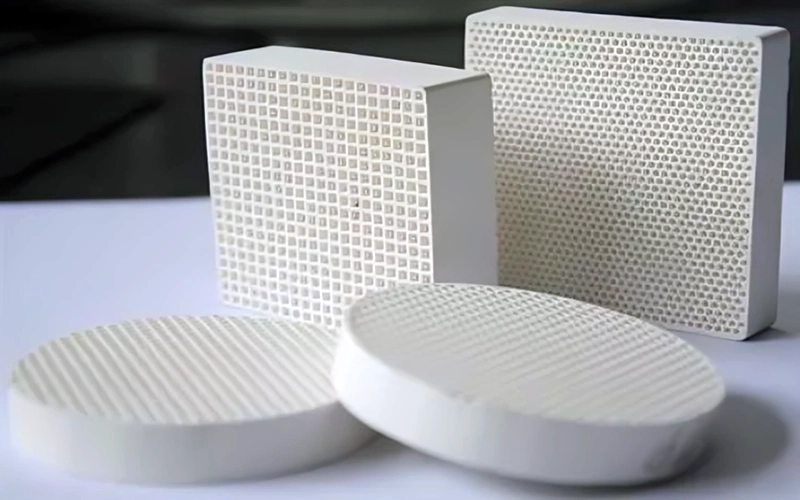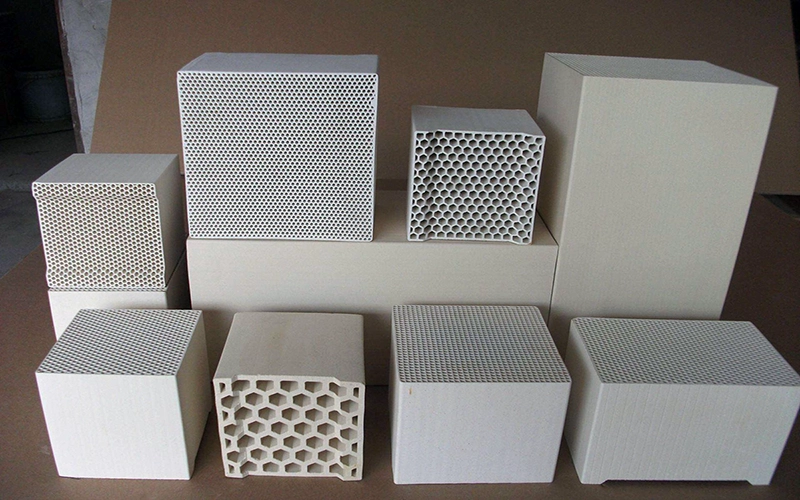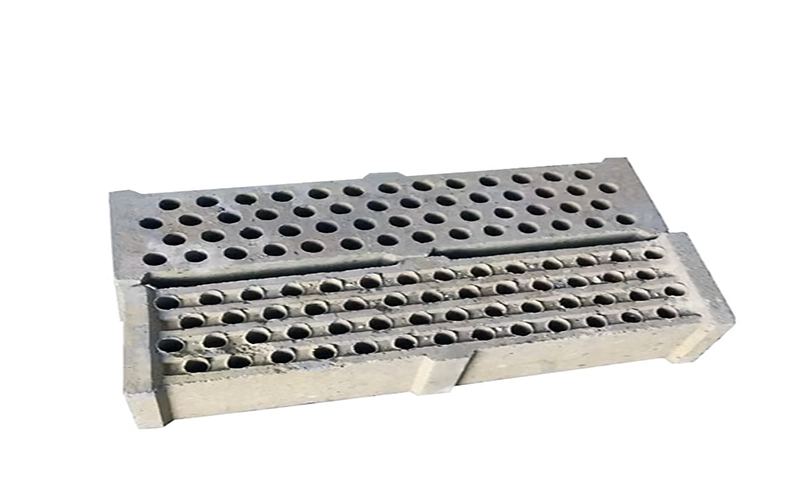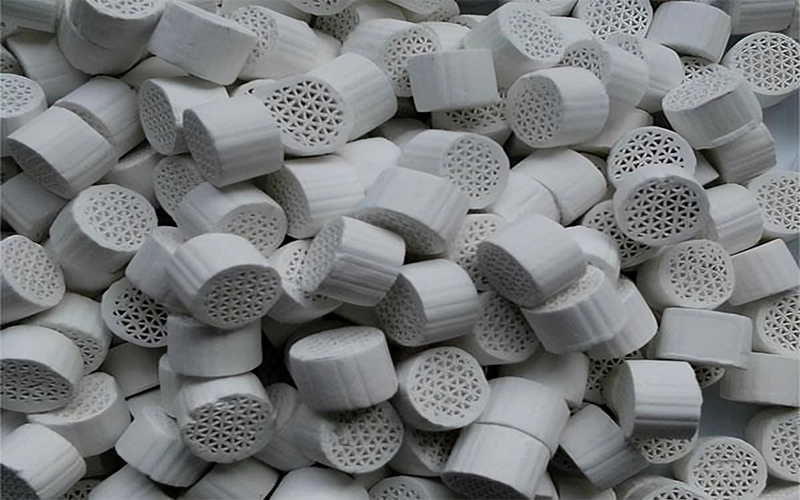Extruded Ceramic Filters are essential components in modern metal casting processes. Manufactured using a high-pressure extrusion technique, these filters typically exhibit a honeycomb structure of straight, parallel channels. This unique design not only provides a large specific surface area but also facilitates an optimal balance between mechanical strength and thermal shock resistance—both crucial attributes when handling molten metal at extremely high temperatures.
The primary function of these filters is to purify molten metal by removing impurities such as refractory fragments, alloy remnants, slag (dregs), and other nonmetallic inclusions. As molten metal flows through the filter’s open-cell, honeycomb structure, these unwanted particles are captured and retained within the porous network. This process prevents them from being incorporated into the final casting, thereby significantly enhancing the structural integrity and surface finish of the product.
Another important aspect is the role the filter plays in regulating the flow of the molten metal. The honeycomb channels provide a rectification effect, transforming a turbulent, chaotic flow into a smooth, steady, and fast laminar flow. By doing so, the filter helps to prevent the formation of bubbles and other turbulence-induced defects. These bubbles, if not controlled, can lead to oxidation and splashing during the pouring process, which in turn may compromise the mechanical properties and overall quality of the casting.
Extruded Ceramic Filters are particularly advantageous in foundry applications that demand high levels of precision and reliability. Their design allows for high metal flow rates with minimal pressure drop, ensuring that the casting process remains efficient even under heavy production loads. Moreover, the filters are engineered to withstand the corrosive environment of molten metals while maintaining their dimensional stability over prolonged use.

The use of these filters ultimately contributes to reducing manufacturing costs. By capturing impurities early in the casting process, extruded ceramic filters help lower the incidence of defects and scrap rates. This not only improves the yield but also enhances tool life and reduces the need for extensive post-casting processing. Industries dealing with high-grade steel, aluminum alloys, and other critical metals benefit greatly from the improved casting quality that these filters provide.
In summary, extruded ceramic filters are indispensable in metal casting due to their ability to efficiently remove impurities and regulate molten metal flow. Their robust, honeycomb structure and excellent thermal properties ensure that the castings produced are of superior quality while simultaneously optimizing the overall efficiency and cost-effectiveness of the manufacturing process.
Overall, extruded ceramic filters provide a robust solution for ensuring that the molten metal entering the mold is as clean as possible, enhancing both the performance and reliability of the final cast components while contributing to significant cost savings in the manufacturing process.

Thanks to these outstanding properties, the extruded honeycomb ceramic heat accumulation substrate has found a wide range of applications across various industries. In the metallurgical sector, it is commonly used in steel-smelting furnaces to remove nitrogen oxides (NOₓ) from flue gases. Here, the substrate serves as a critical component in NOₓ purification systems, where its ability to store and exchange heat helps to optimize the thermal conditions necessary for effective pollutant removal.
Beyond metallurgy, the substrate is employed in energy conservation applications such as steel rolling stoves and thermal power plants. Its role in these systems is to enhance energy efficiency by managing and recycling heat that would otherwise be wasted. Moreover, it is utilized in waste gas purification systems in incinerators and in chemical industry towers, where its robust heat management capabilities contribute to reducing harmful emissions.
In the mining industry, the substrate supports purification systems designed to mitigate virulent gases, thereby ensuring safer working conditions. It is also incorporated into heat exchangers for contact burning processes, where it efficiently transfers heat to improve combustion efficiency and overall energy utilization. Overall, the extruded honeycomb ceramic heat accumulation substrate stands out as a versatile and indispensable material in modern industrial applications, providing an effective solution for advanced thermal management challenges.
The extruded honeycomb ceramic heat accumulation substrate is a high-performance material engineered for optimal thermal management in industrial applications. This substrate is distinguished by its low coefficient of thermal expansion, expansive specific surface area, superior heat stability, and excellent resistance to corrosion. These attributes make it an ideal medium for both heat storage and heat exchange, enabling it to absorb, retain, and efficiently transfer thermal energy under demanding conditions.
One of the key benefits of this substrate is its low thermal expansion coefficient. In environments where temperatures fluctuate significantly, materials that expand or contract excessively can lead to structural stress or failure. The honeycomb ceramic substrate, however, maintains dimensional stability even when subjected to rapid temperature changes. This inherent stability is critical in high-temperature industrial processes, ensuring consistent performance and reliability over extended periods.
The substrate’s large surface area is another notable feature. Its honeycomb structure creates a network of interconnected pores, which not only increases the material’s overall surface but also enhances its capacity for heat exchange. The increased surface area allows for more efficient absorption of thermal energy and accelerates heat transfer, thereby improving the overall efficiency of heat accumulation and dissipation. This makes the substrate particularly effective in applications where rapid thermal response is necessary.
Thermal stability is also a major advantage of this material. The substrate is designed to operate reliably in extreme temperature environments without degrading or losing its functional properties. This high-temperature resilience is essential for applications in thermal power plants and industrial furnaces, where materials are exposed to continuous heat and must sustain their performance over time.
Additionally, the excellent anti-corrosion properties of the honeycomb ceramic substrate ensure durability in chemically aggressive environments. Its resistance to oxidation and corrosive gases makes it well-suited for integration into systems where long-term exposure to harsh chemicals or pollutants is expected. This durability not only extends the lifespan of the substrate but also reduces maintenance costs and downtime in industrial settings.
Baffle bricks are critical components in industrial furnaces that employ regenerative combustion technology. When paired with honeycomb ceramic heat exchangers, these bricks play an essential role in protecting the delicate honeycomb ceramics from direct exposure to high temperatures, aggressive atmospheres, and particulate matter. Installed in front of the honeycomb structures, baffle bricks act as a sacrificial barrier, significantly extending the operational lifespan of the heat exchanger system by reducing thermal shock and physical wear.
One of the primary functions of baffle bricks is to create a stable, controlled environment within the furnace. By deflecting the combustion gases, they ensure even heat distribution and prevent localized overheating, which can lead to premature degradation of the honeycomb ceramic elements. This protective layer also minimizes the accumulation of slag and corrosive deposits on the honeycomb surfaces, thereby maintaining optimal heat transfer efficiency and reducing the frequency of maintenance shutdowns.
Baffle bricks are manufactured from a range of advanced refractory materials designed to meet the rigorous demands of high-temperature industrial environments. Common materials include corundum-mullite, zirconia-mullite, and carborundum (silicon carbide). Each of these materials offers unique advantages:
Corundum-Mullite: Known for its excellent high-temperature stability and resistance to thermal shock, this composite material provides a reliable barrier that endures the cyclical heating and cooling cycles of regenerative furnaces.
Zirconia-Mullite: With its low thermal expansion coefficient and superior refractory properties, zirconia-mullite baffle bricks are particularly well-suited for furnaces operating at extreme temperatures. They offer enhanced durability and improved resistance to chemical corrosion.
Carborundum (Silicon Carbide): Renowned for its high hardness and excellent resistance to abrasion, silicon carbide-based baffle bricks excel in applications where mechanical wear is a significant concern.

Furthermore, baffle bricks can be tailored to meet specific customer requirements. Manufacturers offer special product variations that feature fine-tuned high-temperature stability, outstanding refractoriness, and minimal thermal expansion. These customized bricks also exhibit strong resistance to chemical corrosion, ensuring that they remain effective even in environments with aggressive gaseous byproducts or impurities.
In summary, baffle bricks are indispensable in regenerative combustion furnaces. By shielding honeycomb ceramic heat exchangers, they not only protect these critical components from damage but also enhance overall furnace efficiency and prolong system life. With the availability of various refractory materials and the option for custom formulations, baffle bricks can be engineered to meet the demanding conditions of modern industrial processes, ensuring reliable performance, energy efficiency, and reduced maintenance costs over extended periods of operation.

Moreover, these supports are an integral part of advanced catalytic systems, including vehicle catalytic oxidizers, regenerative catalytic oxidizers, and ReNOₓ processes, as well as fixed-bed adsorbers and various bio-systems designed for environmental remediation. The effectiveness of these systems largely depends on the durability and performance of the catalyst support. Honeycomb ceramics are engineered to exhibit a small coefficient of thermal expansion, high refractoriness, and excellent resistance to both thermal and chemical degradation. These characteristics ensure that the catalyst coating remains intact and active over long periods of operation, even under severe conditions.
In summary, honeycomb ceramic catalyst supports serve as the backbone for numerous catalytic processes, providing a reliable and efficient platform for catalyst deposition. Their advanced design and material properties make them indispensable in reducing harmful emissions, improving air quality, and enhancing the overall efficiency of both automotive and industrial purification systems.
Honeycomb ceramic catalyst supports are a critical component in many emission control and purification systems due to their unique structure and robust properties. These supports are designed with an intricate honeycomb configuration that provides an exceptionally high surface area and a network of interconnected pores. This structure is ideal for the uniform deposition of catalyst coatings, making the supports an effective substrate for catalytic applications.
In automotive applications, honeycomb ceramic catalyst supports are primarily used in exhaust catalytic converters. The high surface area facilitates rapid diffusion of exhaust gases, ensuring optimal contact between the gases and the catalyst. This results in the efficient conversion of harmful emissions—such as carbon monoxide (CO), nitrogen oxides (NOₓ), unburned hydrocarbons (HC), and volatile organic compounds (VOCs)—into less harmful substances before they are released into the atmosphere.
Beyond automotive uses, these ceramic supports play a vital role in various industrial processes. They are extensively applied in the abatement of volatile organic compounds, hazardous air pollutants, and other toxic substances like sulfur dioxide (SO₂) and organic particulate matter in sectors such as the oil and chemical industries. For instance, in industrial waste gas purification systems—such as those in incinerators, power plants, and dust-burning stoves—the supports contribute to reducing emissions by facilitating the catalytic oxidation of pollutants. Their high thermal stability and resistance to chemical corrosion allow them to function effectively even under the extreme temperatures and aggressive environments typical of these applications.
Honeycomb ceramic catalyst supports are also used to improve air quality in commercial and public spaces. In air-freshener systems for hotels, restaurants, and public restrooms, these supports serve as the substrate for catalysts that break down odor-causing compounds. By decomposing these compounds into non-odorous byproducts, the supports help maintain a fresh and pleasant indoor environment.

© 2013 Vertix Co. All Rights Reserved. Leading Supplier Of Foundry & Metallurgical Materials